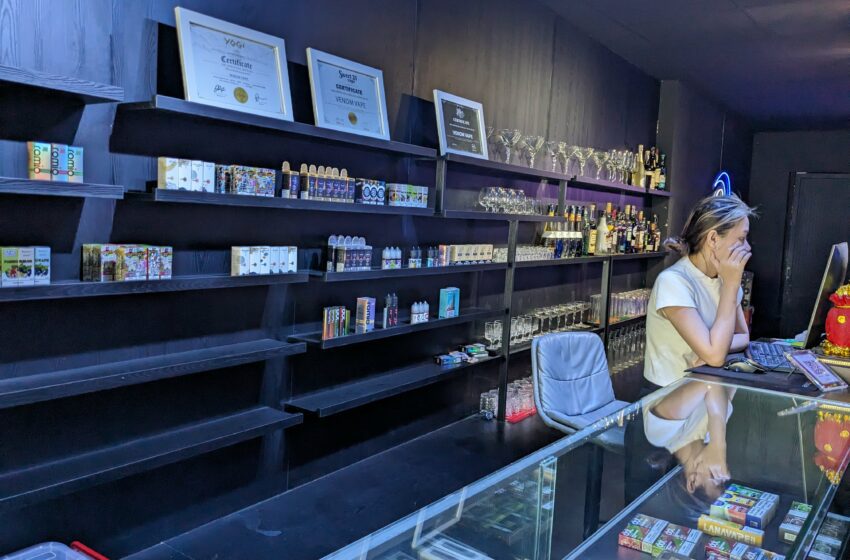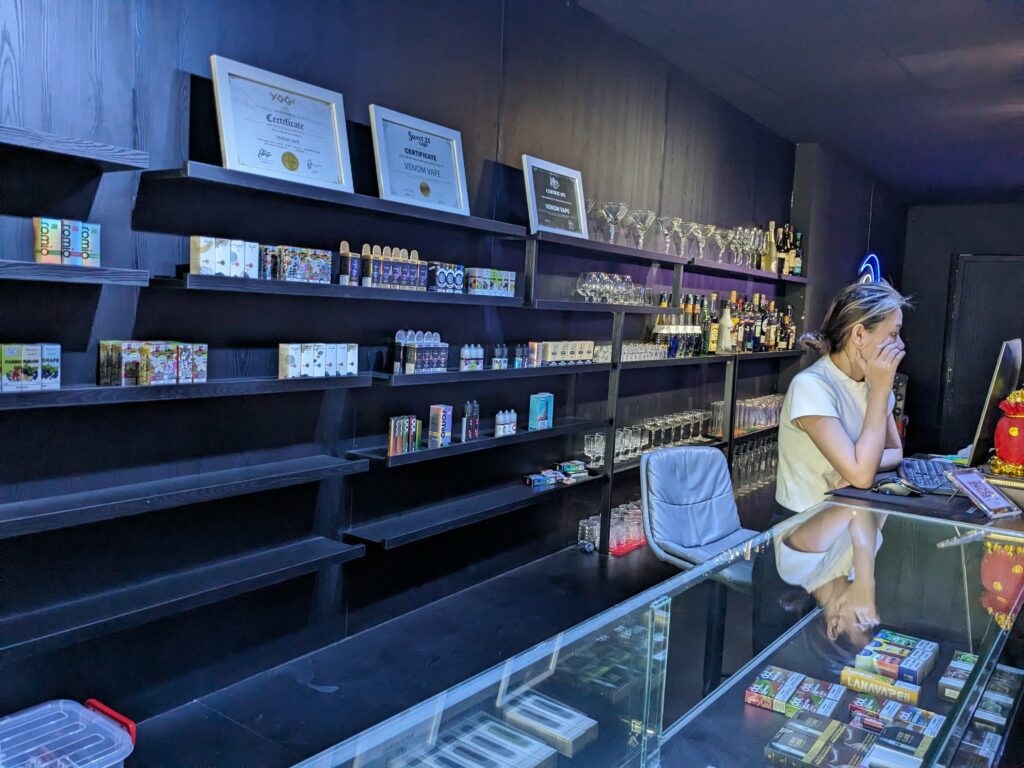Vaping in Vietnam
- This Issue
- March 4, 2024
- 9 minutes read

A vape shop in Vietnam.

E-cigarettes continue to compete in Vietnam, but combustible smoking remains popular.
By Norm Bour
Vietnam may not be your traditional “tobacco-growing country.” The country has less than 15,000 hectares (37,000 acres) under cultivation while neighboring China produces almost 40 percent of the world’s tobacco. However, the tobacco industry in Vietnam does employ about a quarter million people. In 2022, market research company Euromonitor International estimated the Vietnamese tobacco industry to be worth an estimated $4.4 billion, approximately 1 percent of the country’s GDP.
Like other countries in Asia, many more men than women in Vietnam smoke combustible cigarettes. According to the World Health Organization, the current smoking rate among men is a staggering 42.3 percent, and the rate for women is only 1.7 percent. Prices for cigarettes are also low by international standards, with a 20-stick pack costing less than $2.00. My wife is not an avid smoker, but she likes her occasional clove, and that set us back $1.80.
A 2021 report on tobacco taxes by the Southeast Asia Tobacco Control Alliance said tobacco prices in Vietnam were getting cheaper and cheaper when compared to the nation’s per capita income. Revenue in the cigarette segment in Vietnam is projected to reach $7.1 billion in 2024. Like many Asian countries, offering cigarettes as a display of good manners has long been a social convention among Vietnamese men.
Along with the cheap price, rules and laws don’t seem to apply here, as I watched teens who were surely under 18 years old buy cigarettes on the street. And there are street vendors on almost every corner in the larger cities. But the good news is that underage smoking overall is declining in Vietnam.
On top of that, Vietnam is a country full of contradictions. On one hand, it is quite militant and strict with laws, and law enforcement people are everywhere. Yet, on the other hand ….
Gambling is illegal, but they build multibillion-dollar casinos, which can legally be used only by foreigners. Obtaining an entry visa is easier than it used to be, but they are very controlling regarding access and departure points, and they allow no latitude to change them.
Motorbikes are ubiquitous in this Asian country, and bike traffic is as bad as everywhere else in this part of the world. Though helmets are required, many shun them. Families of four, including infants, ride down the street helmet-free as well as preteens who have not reached puberty. The government generally outlaws indoor smoking unless you are in one of many exempted areas, but, in my mind, it is not smoking that should be regulated—it’s traffic laws that make crossing a major street a life-threatening endeavor.
The e-cigarette industry in Vietnam is currently experiencing a surge in popularity among younger people as they seek out a modern and trendy option to traditional smoking. As of now, Vietnam has not implemented any regulations regarding vaping. However, the government has stated that it is working toward introducing a new law regulating its usage and distribution.
The e-cigarette market in Vietnam is projected to generate revenue of $23.9 million in 2024 and to grow at a rate of 1.27 percent annually between 2024 and 2028, according to Statista. When compared globally, the United States generates the highest revenue in the vaping segment, with a projected revenue of $8.8 billion in 2024.
In Ho Chi Minh City, which was previously known as Saigon, I visited several vape shops, and, as has been the case in all my worldwide visits, some look decrepit and uninviting, and some feel like a modern shop in America or England.
One of the busiest streets in Saigon is Bui Vien Street, which is filled with hundreds of different bars and eateries (imagine Bourbon Street in New Orleans) and is called a “walking street” since it’s so popular for tourists and locals. As you might expect, with so much street traffic, I found three vape shops in close proximity.
Vaping Venom offered an inviting modern concrete decor look and offered very little in the way of liquids but instead had a decent display of disposables. It also sold liquor, a nice surprise whenever I encounter a vape shop that does both.
When I asked the counter girl which was more expensive, vaping or cigarettes, she confirmed that vaping was more costly. She also shared that the store caters more to tourists, and since customs in Vietnam can be more troublesome than in other countries, tourists only want disposables, which are cheap if they need to toss them.
Vaping Venom’s offerings included Waka, manufactured by Shenzhen Yuxi Electronic Technology. While still more expensive than tobacco, the product is reasonably priced, perhaps due to the proximity of China to Vietnam. Locals usually buy and Wake vapes. And they are cheaper over the long term.
Vaping 24h was around the corner (with no sign in front), and though the curb appeal was not as good, its inventory was more robust, with a significantly larger supply of liquids, though also dominated by Waka juice. In broken English, the counterman at Vaping 24h verified: “We sell more to locals.”
Viet Vape was my last visit of the day, and I chuckled when I passed a large school letting out their students for lunch. Even though Vietnam forbids under-age-18 tobacco sales, within a five-minute walk of the school were three vape shops. The legal distance from schools for tobacco sales is 100 meters, which is less than a two-minute walk. Other countries are similar and restrict sales within 1,000 feet (almost 305 meters), which is common in the U.S.
I was reading a report of a woman selling cigarettes in front of a local high school. The penalty for this is a fine of VND3 million ($123) to VND5 million, along with forfeiture of the delinquent’s tobacco selling license for up to three months and the confiscation of their products.
The counter guys at Viet Vape were a bit suspicious of my inquiries, but since they had impressive displays of liquids, my assumption of catering more to locals was confirmed by them. And since Vietnam—and Asia in general—offers exotic fruits less known by American vapers, this is a great place to experiment. As we have seen over the past decade, flavor choices, especially fruits, keep people vaping.
Dragon fruit, lychee, and kiwi combinations are abundant here while grapefruit, mango and papaya are available worldwide. Plus, since Vietnam is the second-largest exporter of tobacco in the world, tobacco vape is also a big seller.
“Tourists only want disposables,” Viet Vape verified, “and they want to be discreet since they get looked at more closely than locals.”
Vaping bans are a worldwide trend, and while many Asian countries ban vapes and e-cig outright,* Vietnam is still pretty lax, as is Malaysia, our next stop on our Asian report series.
Norm Bour is the founder of VapeMentors and works with vape businesses worldwide. He can be reached at norm@VapeMentors.com.

